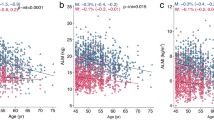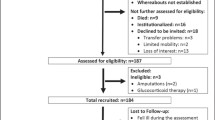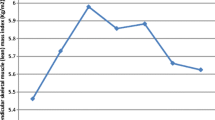Abstract
Summary
The prevalence of sarcopenia increases with age. The diagnosis of sarcopenia relies in part on normative data on muscle mass, but these data are lacking. This study provides population-based reference data on muscle mass in young men, and these results may be used clinically for the diagnosis of sarcopenia in men.
Introduction
The ageing population increases the prevalence of sarcopenia. Estimation of normative data on muscle mass in young men during the peak of anabolic hormones is necessary for the diagnosis of sarcopenia in ageing males. The purposes of this study were to provide population-based reference data on lean body mass (LBM) in young men during the time of peak levels of GH/IGF-1 and testosterone and further to apply the reference data on a population-based sample of men aged 60–74 years to estimate the prevalence of sarcopenia.
Methods
This is a cross-sectional, population-based single-centre study. Our participants are from random selection of 783 men, aged 20–29 years, and 600 men, aged 60–74 years. LBM was assessed by dual-energy X-ray absorptiometry (DXA). LBM T-scores were calculated on the basis of LBM in the young participants. Muscle function in the lower extremities was measured using a leg extension power (LEP) rig in the ageing participants.
Results
Total lean body mass (TLB) was (mean (SD)) 64.7 kg (6.8) in the young and 60.4 kg (6.4) in the ageing men (p < 0.001). Lower extremity lean mass (LELB) was 22.0 kg (2.6) in the young and 19.2 kg (2.4) in the ageing men (p < 0.001). In the ageing men, TLB and LELB T-scores were −0.64 (0.94) and −1.09 (0.94). A total of 4.8 and 8.5 % had a TLB or LELB T-score of less than −2 and a LEP in the lowest quartile.
Conclusions
This study provides population-based reference data on LBM in men, and these data may be used clinically for the diagnosis of sarcopenia.


Similar content being viewed by others
References
Delmonico MJ, Harris TB, Lee JS et al (2007) Alternative definitions of sarcopenia, lower extremity performance, and functional impairment with aging in older men and women. J Am Geriatr Soc 55(5):769–774
Roubenoff R (2001) Origins and clinical relevance of sarcopenia. Can J Appl Physiol 26(1):78–89
Gallagher D, Visser M, De Meersman RE et al (1997) Appendicular skeletal muscle mass: effects of age, gender, and ethnicity. J Appl Physiol 83(1):229–239
Wickham C, Cooper C, Margetts BM, Barker DJ (1989) Muscle strength, activity, housing and the risk of falls in elderly people. Age Ageing 18(1):47–51
Baumgartner RN, Koehler KM, Gallagher D et al (1998) Epidemiology of sarcopenia among the elderly in New Mexico. Am J Epidemiol 147(8):755–763
Janssen I, Heymsfield SB, Ross R (2002) Low relative skeletal muscle mass (sarcopenia) in older persons is associated with functional impairment and physical disability. J Am Geriatr Soc 50(5):889–896
Melton LJ 3rd, Khosla S, Crowson CS, O’Connor MK, O’Fallon WM, Riggs BL (2000) Epidemiology of sarcopenia. J Am Geriatr Soc 48(6):625–630
Ferrucci L, Guralnik JM, Buchner D et al (1997) Departures from linearity in the relationship between measures of muscular strength and physical performance of the lower extremities: the women’s health and aging study. J Gerontol A Biol Sci Med Sci 52(5):M275–M285
Goodpaster BH, Park SW, Harris TB et al (2006) The loss of skeletal muscle strength, mass, and quality in older adults: the health, aging and body composition study. J Gerontol A Biol Sci Med Sci 61(10):1059–1064
Cruz-Jentoft AJ, Baeyens JP, Bauer JM et al (2010) Sarcopenia: European consensus on definition and diagnosis: report of the European working group on sarcopenia in older people. Age Ageing 39(4):412–423
Patel HP, Syddall HE, Jameson K et al (2013) Prevalence of sarcopenia in community-dwelling older people in the UK using the European working group on sarcopenia in older people (EWGSOP) definition: findings from the Hertfordshire cohort study (HCS). Age Ageing 42(3):378–384
Cherin P, Voronska E, Fraoucene N, de Jaeger C (2014) Prevalence of sarcopenia among healthy ambulatory subjects: the sarcopenia begins from 45 years. Aging Clin Exp Res 26(2):137–146. doi:10.1007/s40520-013-0132-8.
Bijlsma AY, Meskers CG, van den Eshof N et al (2014) Diagnostic criteria for sarcopenia and physical performance. Age (Dordr) 36(1):275–285
Morley JE (2008) Sarcopenia: diagnosis and treatment. J Nutr Health Aging 12(7):452–456
Bean JF, Leveille SG, Kiely DK, Bandinelli S, Guralnik JM, Ferrucci L (2003) A comparison of leg power and leg strength within the InCHIANTI study: which influences mobility more? J Gerontol A Biol Sci Med Sci 58(8):728–733
Skelton DA, Kennedy J, Rutherford OM (2002) Explosive power and asymmetry in leg muscle function in frequent fallers and non-fallers aged over 65. Age Ageing 31(2):119–125
Kuo HK, Leveille SG, Yen CJ et al (2006) Exploring how peak leg power and usual gait speed are linked to late-life disability: data from the national health and nutrition examination survey (NHANES), 1999–2002. Am J Phys Med Rehabil 85(8):650–658
McDermott MM, Liu K, Tian L et al (2012) Calf muscle characteristics, strength measures, and mortality in peripheral arterial disease: a longitudinal study. J Am Coll Cardiol 59(13):1159–1167
Nielsen TL, Wraae K, Brixen K, Hermann AP, Andersen M, Hagen C (2006) Prevalence of overweight, obesity and physical inactivity in 20- to 29-year-old, Danish men. Relation to sociodemography, physical dysfunction and low socioeconomic status: the Odense androgen study. Int J Obes (Lond) 30(5):805–815
Frost M, Wraae K, Gudex C et al (2012) Chronic diseases in elderly men: underreporting and underdiagnosis. Age Ageing 41(2):177–183. doi:10.1093/ageing/afr153.
Frost M, Wraae K, Nielsen T et al (2013) Similar reference intervals for total testosterone in healthy young and elderly men: results from the Odense Androgen Study. Clin Endocrinol (Oxf) 78(5):743–751. doi:10.1111/cen.12042.
Bassey EJ, Short AH (1990) A new method for measuring power output in a single leg extension: feasibility, reliability and validity. Eur J Appl Physiol Occup Physiol 60(5):385–390
Blackwell T, Cawthon PM, Marshall LM, Brand R (2009) Consistency of leg extension power assessments in older men: the osteoporotic fractures in Men (MrOS) study. Am J Phys Med Rehabil 88(11):934–940
Volpato S, Bianchi L, Cherubini A et al (2014) Prevalence and clinical correlates of sarcopenia in community-dwelling older people: application of the EWGSOP definition and diagnostic algorithm. J Gerontol A Biol Sci Med Sci 69(4):438–446. doi:10.1093/gerona/glt149.
Frost M, Wraae K, Abrahamsen B et al (2012) Osteoporosis and vertebral fractures in men aged 60–74 years. Age Ageing 41(2):171–177
Aadahl M, Beyer N, Linneberg A, Thuesen BH, Jorgensen T (2011) Grip strength and lower limb extension power in 19–72-year-old Danish men and women: the Health2006 study. BMJ Open 1(2):e000192
Studenski SA, Peters KW, Alley DE et al (2014) The FNIH sarcopenia project: rationale, study description, conference recommendations, and final estimates. J Gerontol A Biol Sci Med Sci 69(5):547–558
Funding sources
Financial support was received from the Novo Nordisk Foundation, World Anti-Doping Agency, the Danish Ministry of Culture, the Clinical Research Institute at the University of Southern Denmark, Novo Nordisk Scandinavia and Pfizer Denmark.
Conflicts of interest
None.
Author information
Authors and Affiliations
Corresponding author
Rights and permissions
About this article
Cite this article
Frost, M., Nielsen, T.L., Brixen, K. et al. Peak muscle mass in young men and sarcopenia in the ageing male. Osteoporos Int 26, 749–756 (2015). https://doi.org/10.1007/s00198-014-2960-6
Received:
Accepted:
Published:
Issue Date:
DOI: https://doi.org/10.1007/s00198-014-2960-6




